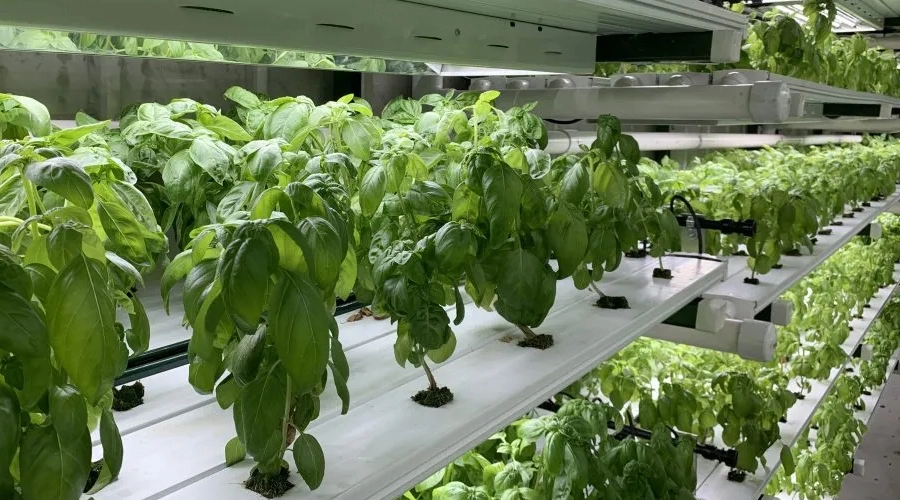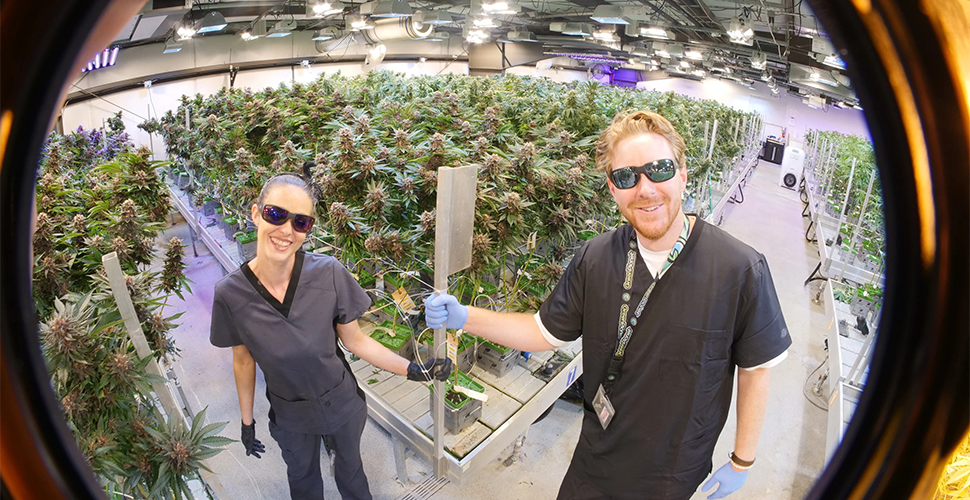Indholdsfortegnelse
Vi ved alle, at jordbær er en af de mest populære havefrugter. Du kan selv dyrke denne duftende, søde og saftige frugt. Jordbær vokser meget godt i jorden, i højbede eller mod et hegn i solen – et naturligt valg. Men har du overvejet fordelene ved at dyrke dem indendørs? Dyrkning af jordbær indendørs med kommerciel drivhusbelysning giver dig mulighed for at producere en afgrøde af lækre bær når som helst på året.

Dyrkning indendørs vil beskytte dine jordbær mod pludselige frost og farligt lave temperaturer samt mod udendørs skadedyr. Ikke kun vil drivhusjordbær tilfredsstille forbrugerne, men de vil også hjælpe avlerne med at opretholde pengestrømmen.
Der er nogle vigtige overvejelser at huske på, før du begiver dig ud i at prøve at bruge et allerede bygget drivhus til jordbærproduktion. I denne artikel tilbyder vi dig en guide til dyrkning af jordbær indendørs. Dette er ikke kun nyttigt til havearbejde i hjemmet, men også til havearbejde i drivhuse.
Valg af jordbærplanter
For at dyrke frugt, grøntsager og planter skal du vælge et udgangspunkt. Du kan dyrke jordbær fra frø, transplantere dem fra jordbærplanter givet af en ven eller købe sunde jordbærplanter i potter fra din lokale købmand.
Lad os starte med at lære om sorterne af jordbær. Vælg en plante, som du kan lide og passer til dig.
De bedste typer jordbær til indendørs dyrkning kaldes dag-neutrale sorter. Disse sorter producerer blomster og frugt hele året rundt, selv på overskyede dage og i kortere dagslysperioder om vinteren. Hvis du bor i et koldt klima, vil disse sorter blive ved med at producere frugt fra oktober til marts eller april.
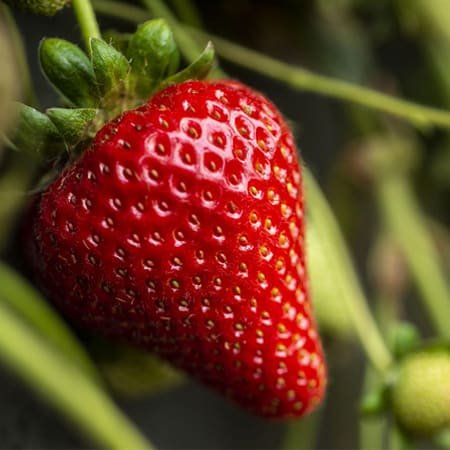
Sommer frugtende jordbær
Fordi det er et lidt større bær, er sommerfrugtende jordbær ideelle til at lave syltetøj, konserves eller tørrede jordbærsprød.
Disse smukke fyre plejer at producere al deres frugt på én gang om to til tre år. De har en kort, men tung høstperiode på to til tre uger. Dette kan være når som helst fra forsommeren til midt- og sensommeren.

Altid bærende jordbær
Evigvarende jordbær vokser i lang tid, fra omkring forsommeren til efterårets første frost. I hele vækstsæsonen får de lidt energi hist og her, så der bliver plukket lidt.
Dens frugter er små og ensartede og har enestående smag. Endnu et kendetegn, det er usandsynligt, at det producerer løbere. Dog falder frugtstørrelsen og den samlede afgrøde i det andet år, og det er bedst at genplante hvert år.

Vilde jordbær
Disse små, skygge-elskende planter producerer små, søde, duftende frugter og tolererer køligere forhold bedre end de fleste jordbær med større frugter.
Det er vigtigt, at de ikke kræver særlig pleje og føler sig glade for at vokse i skyggen.
Hvordan dyrker man jordbær indendørs?
Jordbær er en af de nemmeste planter at dyrke indendørs med kommerciel drivhusbelysning. De er også et godt supplement til enhver have eller drivhus.
Jorddyrkning og hydroponisk dyrkning er begge ideelle indendørs dyrkningsmetoder.
Faktorer, der skal tages i betragtning, når man dyrker jordbær er: jordbærsort, plantetidspunkt, placering, landbrugssystem, venligt miljø, pleje og vedligeholdelse, høst af bær, renovering af bærbede og beskyttelse af jordbærplanter mod skader i hvilemåneder.
Hvordan dyrker man jordbær i en jordbærpotte?

For at vokse indendørs i konventionel jord skal du bruge følgende førende værktøjer.
- Såpotter: Jordbær er planter med lavt rod. Du skal bruge en 6 til 8-tommer dyb potte, helst en vinduesplantemaskine. Den vil rumme tre planter, holde 3 til 4 tommer mellem hver plante, så vi kan have en fin lille udstilling.
- Potteblanding: Standard potteblanding/tørveblandinger til alle formål. Lerjord anbefales ikke. Med tiden bliver jorden mere kompakt og vil ikke dræne godt.
- Gødning: Balanceret gødning. Dette bør være lige dele af nitrogen, fosfor og kalium.
- Drivhuslys til planter: Det kan give hvad der svarer til mere end 6 timers direkte sollys.
Plant jordbærfrø
Sandt at sige, er det sikkert svært at dyrke alt fra frø. Hvis du er en novice, vil det være relativt nemt at starte med jordbærpotter.
- Hvis du bruger frø, skal du lægge dem i blød natten over, før du planter dem i en bakke fyldt med potteblanding.
- Næste dag skal du vælge en gryde med åbent vindue til næste trin. Planlæg, at hvert rumstationssted skal være 4 tommer fra hinanden. For hver station skal du trykke 4 frø ind i overfladen. Husk at holde jorden varm og temperaturen kontrolleret på 40-60°F, helst 60°F.
- Sørg for at sprøjte dem med vanding hvert par dage for at holde dem fugtige, indtil de spirer.
Transplanterede jordbærplanter
For at transplantere jordbærplanter med bare rod skal du følge disse trin.
- Forbered en bred og lavvandet potte og fyld den med ½ af jorden, og form leret til en konisk form.
- Forbered en jordbær bar rod og klip eventuelle rødder af, der ser usunde ud. Form den derefter til en kegle, så den passer til jorden i potten.
- Dæk de højeste rødder med jord og juster jorden efter behov.
- Afslut med en grundig vanding.
Tjek efter nye skud (uge 2-3)
Frøene vil snart spire og kan transplanteres, når de har 3-4 ægte blade. Du kan se frøplanter på så lidt som 7 dage, eller muligvis 20 dage. Hvis du efter 30 dage stadig ikke har nogen spiring, er dit setup sandsynligvis for koldt.
Tynd dine frøplanter (uge 4)
Fortynd dine frøplanter til kun én frøplante pr. sted, så de største planter efterlades. Ved at fjerne de mindre frøplanter lader du de største, stærkeste frøplanter trives ved at mindske konkurrencen om vand, mad og plads.
Krav til dyrkning af jordbær indendørs
Beliggenhed
Under begrænsede omstændigheder er naturligt indendørs lys tilstrækkeligt til, at jordbærplanter kan vokse godt.
Hvis du bor i et køligt klima, placerer du dem i nærheden af et sydvendt vindue eller glasdør, så de får lidt direkte sollys også om vinteren.
Hvis du bor i et område med milde vintre, kan du sætte dem udenfor om sommeren og bringe dem indenfor, når temperaturen falder til under 50 grader Fahrenheit (10 grader Celsius).
Sørg også for, at du ikke placerer jordbærplanter i nærheden af de varme og kolde ventilationskanaler på klimaanlæg og varmeapparater. Jordbærplanter foretrækker temperaturer på 55 til 75 grader Fahrenheit (12 til 24 grader Celsius). Hvis det bliver for varmt, kan du opleve, at dine jordbær begynder at smelte.

Belysning
Under begrænsede omstændigheder er naturligt indendørs lys tilstrækkeligt til, at jordbærplanter kan vokse godt.
Hvis du vil dyrke mange jordbær, har du stadig brug for drivhusbelysningsmuligheder for at hjælpe med væksten. For en introduktion til det, besøg venligst vores indlæg på hvordan vokselys fungerer bedre for planter.
Jordbærplanter har brug for, hvad der svarer til mere end 6 timers direkte sollys for at vokse bedst. Hvis dit hjem eller din lejlighed ikke har nok naturligt lys, bliver du nødt til det vælge en vokse lys for at hjælpe med plantevækst.
Fluorescerende lys producerer meget lidt varme og kræver ikke specielle reflektorer eller kølesystemer. Imidlertid, fuld spektrum LED drivhusbelysning er velegnet til indendørs dyrkning. LED'er er ideelle til dyrkning af jordbær indendørs på grund af deres lave varmeeffekt, høje effektivitet og rige spektrum. De har også en lang levetid, hvilket betyder, at du ikke behøver at udskifte dem i årevis, efter du har dyrket dine jordbærplanter.
Følg producentens anvisninger og placer kommercielle drivhus-LED-dyrkningslys omkring 12 tommer over jordbærplanterne for at give nok lys til, at de kan trives. Du kan bruge en timer til at få den til at slukke automatisk efter solnedgang, eller slå den fra manuelt for at lade dine jordbærplanter hvile om natten.
Jordbær er kortdagsplanter, hvilket betyder, at de vil vokse hurtigere, hvis de har brug for mere end 12 timers mørke. Hvis du vil have dem til at blomstre hurtigst muligt, kan drivhusets kunstige lys kun tændes i 10 timer om dagen.
Potteblandinger
Vælg venligst en standard potteblanding eller en universal tørveblanding, lerjord anbefales ikke. Med tiden bliver jorden mere kompakt og vil ikke dræne godt.
Vanding
Ulempen ved jordbærpotteplanter er, at de skal vandes regelmæssigt. Og man skal virkelig passe på med vanding, for planterne i toppen får det meste af vandet. Desuden vil leret lede fugt væk, hvilket gør det mindre velegnet i varmere klimaer.
Hvis der ikke er meget sol, og luften omkring planten er kold og våd, skal du kun vande, når 1 tomme muldjord er tør. Morgen er det bedste tidspunkt at vande!
Når du har en terracottagryde, som du er særlig glad for og ser godt ud, men du ikke vil vande den ofte, er der én ting, du kan gøre. Læg en film over, eller sæt en lun plastikgryde indeni terracottagryden, så får du alle fordelene ved en terracottagryde. Dræb to fluer med ét smæk, uden at være upraktisk.
Gødning
Uanset hvilket mærke af gødning du vælger, skal du sørge for, at den indeholder calcium og magnesium, især hvis din jord er sur. Du kan også fodre dine jordbær med tomat- eller rosegødning, når blomstringen er startet.
Hvis dine jordbærplanter viser symptomer på overbefrugtning, såsom gulning eller visning af de nederste blade, brunfarvning af bladspidserne og -kanterne, skal du reducere gødningsdosis eller forlænge varigheden af genbefrugtningen.
Beskæring
Nogle gange har jordbær denne meget lange stilk kaldet “løber”. Det er den måde, jordbæret formerer sig på. Jordbæret sender disse løbere ud, så de kan røre jorden, producere rødder, og så er der en ny lille plante.
Vi ønsker dog ikke at producere løbere i det første år af plantningen. Vi ønsker snarere at koncentrere plantens energi og trives på dette stadium. Der er også behov for at fjerne uønskede blomster.
Skadedyr og sygdomme
En af de største fordele ved at dyrke jordbær indendørs er, at du ikke behøver at bekymre dig om skadedyr. Du skal dog stadig passe på almindelige havemider og bladlus.
Bestøvning
Du er nødt til at bestøve jordbærblomsterne manuelt, og det er nok med enhver blød børste.
Hvordan dyrker man jordbær hydroponisk?
Hydroponiske jordbær er en effektiv, ren og sjov ny måde at dyrke jordbær på. Det giver dig mulighed for at dyrke dine yndlingsjordbær i komfort i dit hjem.
Hjemmehavearbejde
Til havearbejde i hjemmet er alt hvad du behøver en automatisk hydroponisk plantemaskine.
Dens indbyggede fuldspektrede små væksthuslamper giver et specifikt spektrum til at opfylde alle planters vækststadier. LED-panelet er designet til 16 timers tændt og 8 timers slukket cyklus. Udstyret med en vandtank med stor kapacitet og mere end 10 bælg, giver den dig plads nok til at dyrke jordbær.
Standard arbejdstilstand for den hydroponiske køkkenhave er 16 timer tændt / 8 timer slukket. For at fremme væksten af grøntsager kan du manuelt indstille forskellige væksttider for dine planter på appen, så du kan nyde høstprocessen.
Alt du skal gøre er at følge trinene i instruktionerne, lægge jordbærfrøene i plantebælgen, tænde plantelyset og stille og roligt vente på, at jordbærene bærer frugt.

Drivhusdyrkere
Hydroponiske jordbærplanter tager 90 til 120 dage at producere frugt. Hvis du bruger den rigtige type hydroponiske dyrkningssystem, får du dobbelt så meget arbejde! Disse varierer meget i pris, antal anlæg og ydeevne. Derfor skal du lave din research, når du køber.
Lodret hydroponisk system
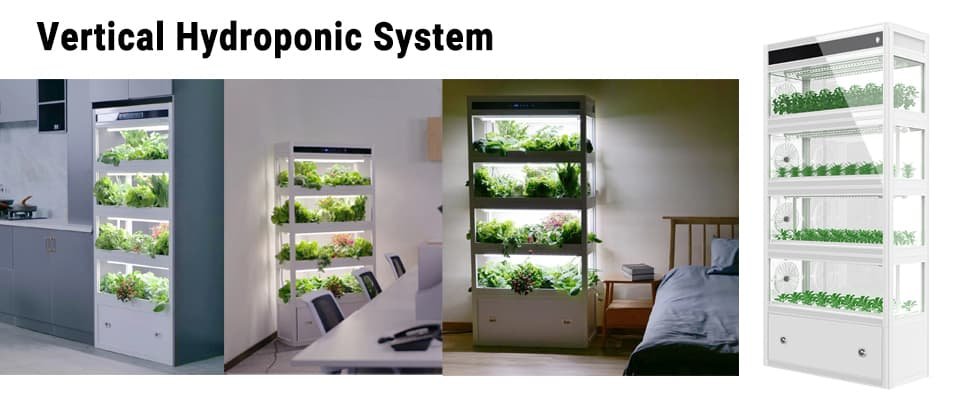
Systemet er meget populært blandt de avlere, der vil dyrke jordbær i hydroponics. Den er velegnet til konstruktion af plantefabrikker i forskellige størrelser, til småskala voksende behov såsom avancerede restauranter og lokalsamfund, og er lige så velegnet til videnskabsfremme og kommercielle udstillingskonfigurationer.
Det er en flerlags modulær struktur, robust og holdbar. Den integrerede struktur af vand og elektricitet og komplette sæt udstyr omfatter kun tre standardgrænseflader for vandforsyning og dræning og elektricitet. Et enkelt sæt udstyr kan fleksibelt gøres-det-selv-tilpasset til forskellige gulvhøjder og gulve.
28 minutter hurtig montage konstruktionsdesign: ifølge styklisten pakning og levering af produkter, installation uden specialværktøj, kan to personer fuldføre installationen af udstyr på 28 minutter.
Ulemper: Høje indledende opsætningsomkostninger, ideel til avlere af kommerciel kvalitet.
Ebbe og Flow System
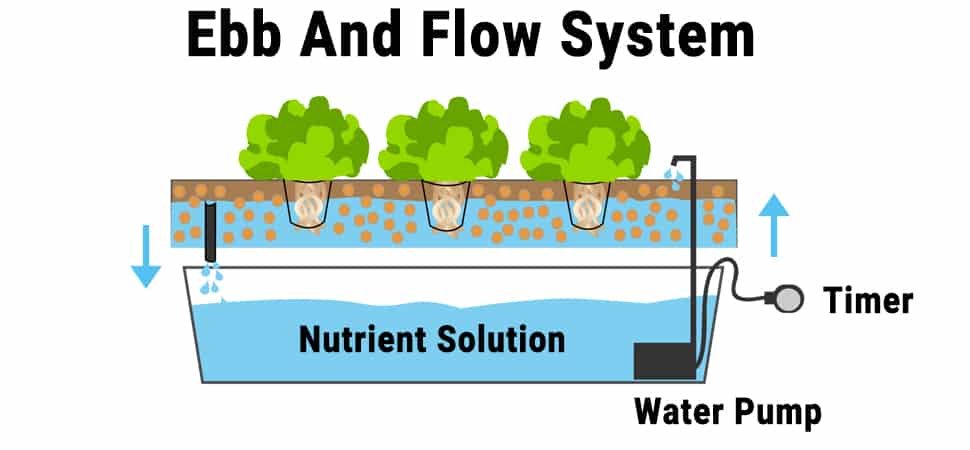
Dette system er mest populært blandt hydroponiske jordbæravlere. Det involverer brugen af en timer til at regulere, hvor ofte vandet pumpes ind i de voksende bakker eller beholdere, der indeholder næringsopløsningen og planter.
Pumpen tænder og slukker, så jordbærrødderne kan absorbere den maksimale mængde næringsstoffer. Det minimerer også vandlidning i tanke, hvor jordbærene dyrkes.
Ulemper: Denne type system kræver mere arbejde, og du skal overvåge og kontrollere, hvornår dette sker. Det vil dog betale sig over tid på grund af de lave vedligeholdelseskrav.
Hydroponisk drypvandingssystem
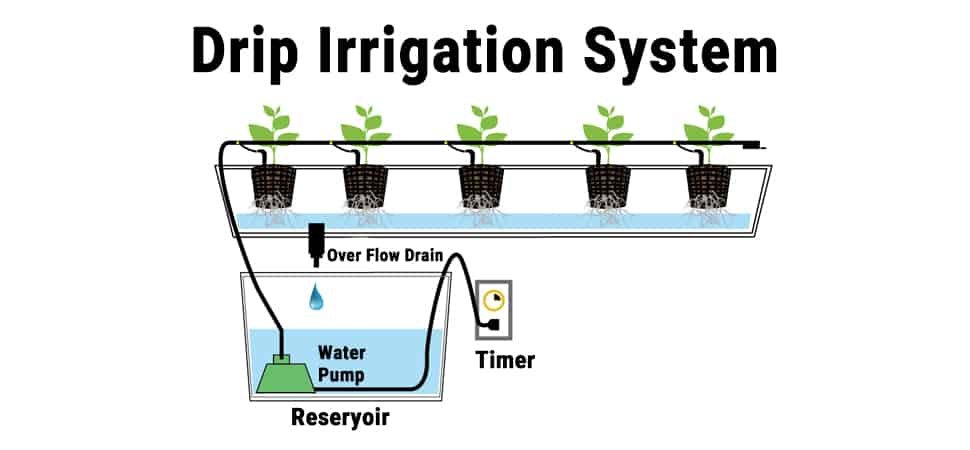
Dette system er også ret nemt at konfigurere, men kræver en investering på forhånd, og du skal bruge en timer og pumpe.
Grundprincippet i dette jordbærdyrkningssæt er, at det er et drypvandingssystem, der skal samles. Planterne sidder ikke i vandet. De er simpelthen ophængt over overfladen, hvilket også betyder mindre chance for råd.
Ulemper: Der er mere arbejde involveret, når du opsætter dette hydroponiske jordbærdyrkningssystem og vedligeholder det regelmæssigt. Og sørg for, at du ikke bliver fristet af billigere sæt!
Næringsfilmteknologi

Nutrient Film Technology (NFT) er perfekt, hvis du leder efter en billig måde at dyrke hydroponisk i din baghave eller på din altan. Men der er mere arbejde involveret her, bare ikke mange forudgående omkostninger.
NFT tillader planter at vokse i en beholder fyldt med næringsopløsning. Anlægget flyder oven på tanken. Der løber altid noget vand igennem det for at give kontinuerlig næring. For at sikre, at det fungerer korrekt, skal du manuelt pumpe væsken på filmen med jævne mellemrum, så den kan dryppe igen og blive der.
Ulemper: Det optager mere vækstplads end andre systemer, fordi du har brug for beholdere eller trug til at dyrke jordbær og vand. Du har også brug for en pumpe for at holde væsken flydende korrekt. På grund af de høje initiale opsætningsomkostninger anbefales NFT kun til avlere af kommerciel kvalitet.
Bedste måned at plante jordbærbukser på
Til hjemmeplantning er det bedst at vælge foråret, når temperaturen er mere egnet til at alt kan gro, og marts-april er den bedste periode. Hvis temperaturen er for høj om sommeren, vil planten være i dvale, og antallet af frugter vil blive påvirket.
Faktisk er jordbær flerårige urter og kan plantes hele året rundt, så længe der er en passende temperatur. Mange jordbær i drivhuse kan som sædvanligt producere frugt om vinteren.
Konklusion
Ved at følge disse tips vil du hjælpe dig med at dyrke disse lækre frugter. Hydroponiske systemer med kommerciel drivhusbelysning kan gøre det nemmere for dig at dyrke jordbær indendørs.
Jordbærdyrkning er enkel og givende, hvis du har et drivhus og den rigtige plads til at dyrke dem. Vi håber, at oplysningerne har været nyttige og vil hjælpe dig med at nyde hjemmedyrkede jordbær i din egen have.
Tjek vores blog for flere voksende vejledninger og tips, som f.eks hvordan man dyrker druer i et drivhus voksende guide og den bedste guide til brug af drivhusbelysningsarmaturer.
Jayes
Som Digital Marketing Manager hos AUXGROW kombinerer Jayes en passion for hydroponiske systemer og ekspertise inden for LED vækstlys. Med praktisk erfaring og en dyb forståelse guider Jayes dig gennem verden af bæredygtig dyrkning.




